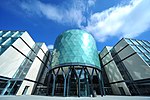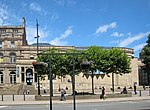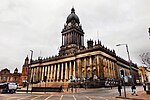Leeds Civic Hall
Buildings and structures in LeedsBuildings by Vincent HarrisCity and town halls in West YorkshireGovernment buildings completed in 1933Grade II* listed buildings in West Yorkshire ... and 3 more
Leeds Blue PlaquesListed buildings in LeedsUse British English from April 2022

Leeds Civic Hall is a municipal building located in the civic quarter of Leeds, West Yorkshire, England. It replaced Leeds Town Hall as the administrative centre in 1933. The Civic Hall houses Leeds City Council offices, council chamber and a banqueting hall, and is a Grade II* listed building. A city landmark, two 2.3 metres (7 ft 7 in) high gold-leafed owls top its twin towers, decorations which are joined by four more owls on columns in Millennium Square, which sits to the front, and a gilded clock on both sides.
Excerpt from the Wikipedia article Leeds Civic Hall (License: CC BY-SA 3.0, Authors, Images).Leeds Civic Hall
Calverley Street, Leeds Woodhouse
Geographical coordinates (GPS) Address External links Nearby Places Show on map
Geographical coordinates (GPS)
| Latitude | Longitude |
|---|---|
| N 53.80214 ° | E -1.5485 ° |
Address
Leeds Civic Hall
Calverley Street
LS1 1UR Leeds, Woodhouse
England, United Kingdom
Open on Google Maps









